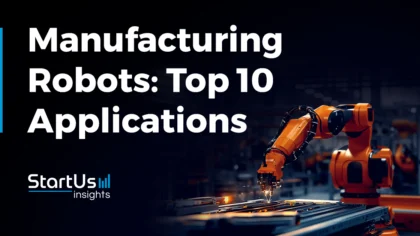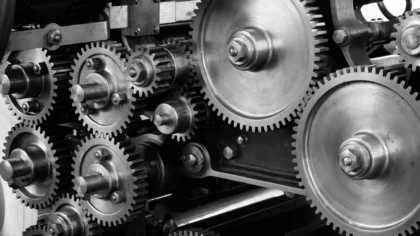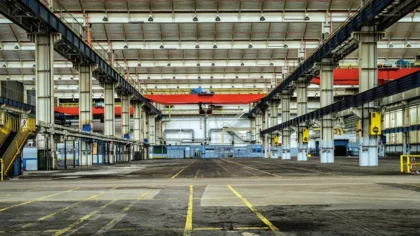The rapid application of robotics in manufacturing is resolving operational challenges and unlocking new efficiencies in the sector. Companies like Cohesive Robotics‘ Smart Finishing Robotic Workcell automates difficult surface finishing tasks, through AI vision and precise force control. This adoption offers flexibility without the need for reprogramming. Similarly, startups like Flip Robotics also adopt pick-and-place technology to solve challenges in processing asymmetric and fragile objects in assembly operations. This technology further improves productivity and supports sustainability goals in the manufacturing sector.
Additionally, with robotics integrated into material handling, welding, quality control, packaging, cutting, painting, and more, manufacturers must adapt to stay competitive in a dynamic landscape. This report explores the top applications of manufacturing robots and highlights the need to embrace these solutions to remain efficient and relevant in the manufacturing industry.
Why should you read this report?
- Gain in-depth insights into the application of robotics in manufacturing
- Learn about three practical use cases
- Meet 10 innovative startups advancing these developments
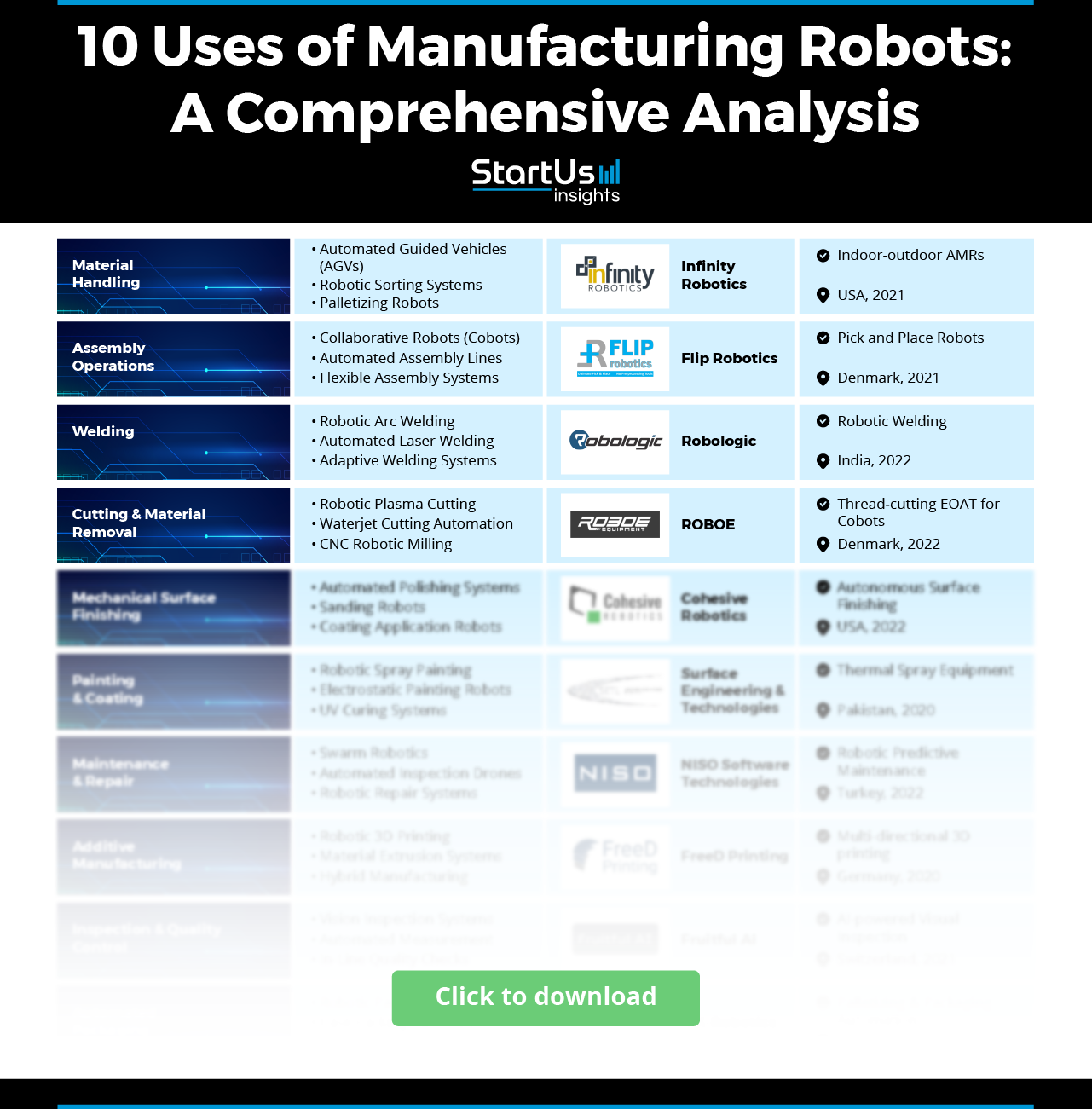
Key Takeaways
- Material Handling
- Use Cases:
- Automated Guided Vehicles (AGVs)
- Robotic Sorting Systems
- Palletizing Robots
- Startup to Watch: Infinity Robotics
- Use Cases:
- Assembly Operations
- Use Cases:
- Collaborative Robots (Cobots)
- Automated Assembly Lines
- Flexible Assembly Systems
- Startup to Watch: Flip Robotics
- Use Cases:
- Welding
- Use Cases:
- Robotic Arc Welding
- Automated Laser Welding
- Adaptive Welding Systems
- Startup to Watch: Robologic
- Use Cases:
- Cutting and Material Removal
- Use Cases:
- Robotic Plasma Cutting
- Waterjet Cutting Automation
- CNC Robotic Milling
- Startup to Watch: ROBOE
- Use Cases:
- Mechanical Surface Finishing
- Use Cases:
- Automated Polishing Systems
- Sanding Robots
- Coating Application Robots
- Startup to Watch: Cohesive Robotics
- Use Cases:
- Painting and Coating
- Use Cases:
- Robotic Spray Painting
- Electrostatic Painting Robots
- UV Curing Systems
- Startup to Watch: Surface Engineering and Technologies
- Use Cases:
- Maintenance and Repair
- Use Cases:
- Swarm Robotics
- Automated Inspection Drones
- Robotic Repair Systems
- Startup to Watch: NISO Software Technologies
- Use Cases:
- Additive Manufacturing
- Use Cases:
- Robotic 3D Printing
- Material Extrusion Systems
- Hybrid Manufacturing
- Startup to Watch: FreeD Printing
- Use Cases:
- Inspection and Quality Control
- Use Cases:
- Vision Inspection Systems
- Automated Measurement
- In-Line Quality Checks
- Startup to Watch: Fruitful AI
- Use Cases:
- Automated Packaging
- Use Cases:
- Robotic Packing Stations
- Case Packing Automation
- End-of-Line Packaging Solutions
- Startup to Watch: YK-Robotics
- Use Cases:
FAQs: Applications of Robotics in Manufacturing
How are robotics used in the manufacturing industry?
Robotics plays a critical role in the manufacturing industry by automating repetitive tasks and improving efficiency, and precision. Many factories utilize robotic arms for assembly line operations, where robots perform welding, painting, and part assembly tasks. Additionally, robots assist in material handling by moving heavy components and finished products within the production environment. Further, integrating robotics in quality control processes allows for real-time inspections, so that products meet required standards and specifications.
What are the benefits of robots in manufacturing?
Robots offer several advantages in the manufacturing sector, primarily through increased productivity and cost savings. Robots reduce production cycle times and improve output levels by operating continuously without breaks. Moreover, robots increase workplace safety by taking on dangerous tasks and minimizing the risk of injury for human workers. Implementing robotic systems also leads to greater precision and consistency that results in higher-quality products and fewer defects.
What is the future of robotics in manufacturing
Manufacturers adopt collaborative robots, or cobots, that work alongside human workers to increase productivity while maintaining safety. The developments in artificial intelligence and machine learning enable robots to adapt to changing production requirements and optimize processes. The ongoing development of smart factories integrates robotics with IoT technologies to facilitate real-time data exchange and more efficient supply chain management. As these trends continue, robotics will transform manufacturing, leading to more agile and responsive production environments.
Where is this Data from?
StartUs Insights provides data through its comprehensive Discovery Platform, which covers 4.7+ million startups, scaleups, and tech companies globally, as well as 20K+ emerging innovations & trends. The platform excels in startup and technology scouting, trend intelligence, and patent searches, offering a detailed view of the innovation landscape. For this report, we analyzed technologies within specific industries using the trend intelligence feature. During this research, we identified patterns and trends, pinpointing relevant use cases and the startups developing solutions for each. More capabilities and details are available at StartUs Insights Discovery Platform.
Top 10 Applications of Robotics in Manufacturing [2025 & Beyond]
1. Material Handling
Robotics in material handling improves operational efficiency and productivity. Sensors, artificial intelligence, and machine learning enable robots to perform complex tasks with precision and reliability. Automated guided vehicles (AGVs), autonomously transport materials along predetermined paths. This solution reduces human labor and minimizes accident risks. Robotic sorting systems automate product sorting by size or type. Besides, palletizing robots stack products onto pallets for shipping or storage. These solutions lower labor costs, increase throughput and allow robots to operate continuously. Additionally, by automating hazardous tasks, companies improve workforce safety. The precision of robotic systems also reduces handling errors and leads to higher product quality and less waste.
Noteworthy Example: FANUC specializes in material handling robots that offer high-speed transfers and applications such as pick-and-place, palletizing, and packaging.
Startup to Watch: Infinity Robotics
US-based startup Infinity Robotics develops custom automation solutions that increase efficiency and reduce business costs. The company uses robotics and artificial intelligence to create tailored systems for pick-and-place operations, material handling, and assembly. Its flagship product, AutoOperator, serves as an entry-level automation solution for machine loading and tending. This solution improves production workflows with a base configuration that adapts to specific needs. The startup also offers mobile robots, specifically autonomous mobile robots (AMRs), which facilitate rapid product deployment throughout operations. These mobile robots excel in wave picking within distribution centers and material movement in manufacturing.
2. Assembly Operations
Manufacturing robots are improving assembly operations through edge computing, collaborative robotics, and 3D printing. Robotic picking and placing minimize downtime by swiftly moving items between points in the manufacturing process. Robotic welding automates the joining of components with high accuracy and repeatability in automotive manufacturing. Additionally, robotic inspection processes accelerate quality assurance by rapidly identifying defects and maintaining high standards. Collaborative robots (cobots) are ideal for tasks that demand human-like dexterity. Automated assembly lines allow manufacturers to quickly adjust production rates in response to demand fluctuations. Flexible assembly systems utilize robots’ programmability to accommodate different product types.
Noteworthy Example: Yaskawa‘s MOTOMAN series of robots are widely used in assembly operations across various industries.
Startup to Watch: Flip Robotics
Flip Robotics is a Denmark-based startup that develops pick-and-place technology and processes asymmetric and fragile objects safely. Its product, the Flip Gripper (FG1), increases operational efficiency and contributes to sustainable development goals (SDGs). This solution also utilizes a unique gripping mechanism for businesses to arrange items on any desired surface with just one grasp. By eliminating tasks that existing solutions struggle to address, the startup offers a smarter and more efficient approach to assembly operations.
3. Welding
In the manufacturing industry, robotics is improving welding processes, efficiency, precision, and safety. Robotic welding systems combine robotic arms, controllers, and integrated sensors for real-time monitoring and adjustments. Robotic arc welding uses gas metal arc welding (GMAW) and gas tungsten arc welding (GTAW) for precision in complex tasks. Besides, automated laser welding offers high accuracy and minimal heat distortion. Adaptive welding systems dynamically adjust parameters in real time to optimize processes. Moreover, these technologies add productivity through continuous operation and improve quality and safety by minimizing human exposure to hazards.
Noteworthy Example: Panasonic offers robotic welding technology that delivers high-quality machines for efficiently handling complex welding tasks in both small-scale and large industrial applications.
Startup to Watch: Robologic
Robologic is an Indian startup that develops customized robotic solutions for process automation, specializing in various welding applications. The startup produces automated systems that integrate MIG, TIG, arc, and cobot welding processes and offers tailored welding solutions. Further, welding SPMs adds productivity and ensures repeatable high-quality welds.
Robologic creates flexible robotic welding cells and offers multiple automation solutions and welding accessories compatible with various processes and equipment. These automation products improve weld results by increasing quality and efficiency in manufacturing. Additionally, Robologic advances Industrial 5.0 through innovative solutions while exceeding customer expectations and delivering high-performance automated systems.
4. Cutting and Material Removal
Integrating robotics into cutting and material removal processes in manufacturing enhances productivity, precision, and safety. By employing sensors, AI algorithms, and robotic arms, manufacturers easily implement automated operations in laser, plasma, and waterjet cutting. This integration offers consistent quality and minimizes human error throughout the cutting process. Additionally, robotic plasma cutting offers high precision when slicing metals.
This technology is effective in increasing speed and accuracy in production. However, waterjet cutting employs high-pressure water combined with abrasives to slice materials. This method is ideal for applications where heat-sensitive materials are involved. CNC robotic milling also automates shaping, and robotic deburring and polishing improve the final product quality. These robotic technologies increase operational efficiency, safety, and product quality in manufacturing.
Noteworthy Example: Mitsubishi Electric provides robotic solutions for material removal, featuring precision material cutting and deburring with better performance and reliability.
Startup to Watch: ROBOE
ROBOE is a Denmark-based startup that develops an End-of-Arm Tool for collaborative robots (cobots) to semi-automate thread-cutting processes for small and medium enterprises (SMEs). This technology increases productivity by replacing manual cutting tasks, which involve poor ergonomics and repetitive strain. By integrating cobots into the workflow, the company allows SMEs to improve operational efficiency while promoting safer working conditions.
5. Mechanical Surface Finishing
Manufacturing robots are effective in automating the polishing, sanding, and coating process. The robotic systems use force sensors and adaptive control mechanisms, to achieve high precision and consistent surface quality across various materials. Automated polishing systems offer uniform finishes on components while sanding robots for different materials improve pressure and speed for optimal results. Coating application robots further increase the production process by delivering consistent, high-quality coatings. Together, these robotic technologies improve operational efficiency, reduce manual labor costs, and meet industry standards.
Noteworthy Example: Acme Manufacturing provides robotic finishing solutions that utilize abrasive and synthetic media for polishing and deburring applications.
Startup to Watch: Cohesive Robotics
US-based startup Cohesive Robotics automates finishing operations with its Smart Finishing Robotic Workcell. This turnkey solution combines Argus OS for AI vision and precise force control for autonomous material removal and surface finishing tasks. The technology also integrates industrial or collaborative robots to perform sanding, grinding, deburring, and polishing on ferrous and non-ferrous metals, wood, stone, and composites, without programming. Its flexible software, interchangeable tooling kits, and intuitive human-machine interface (HMI) perform ASTM standard finishes or configure unique parameters for specific job requirements. Additionally, the system eliminates time-consuming robot reprogramming, supports low volumes to lot size, and adapts to production demands.
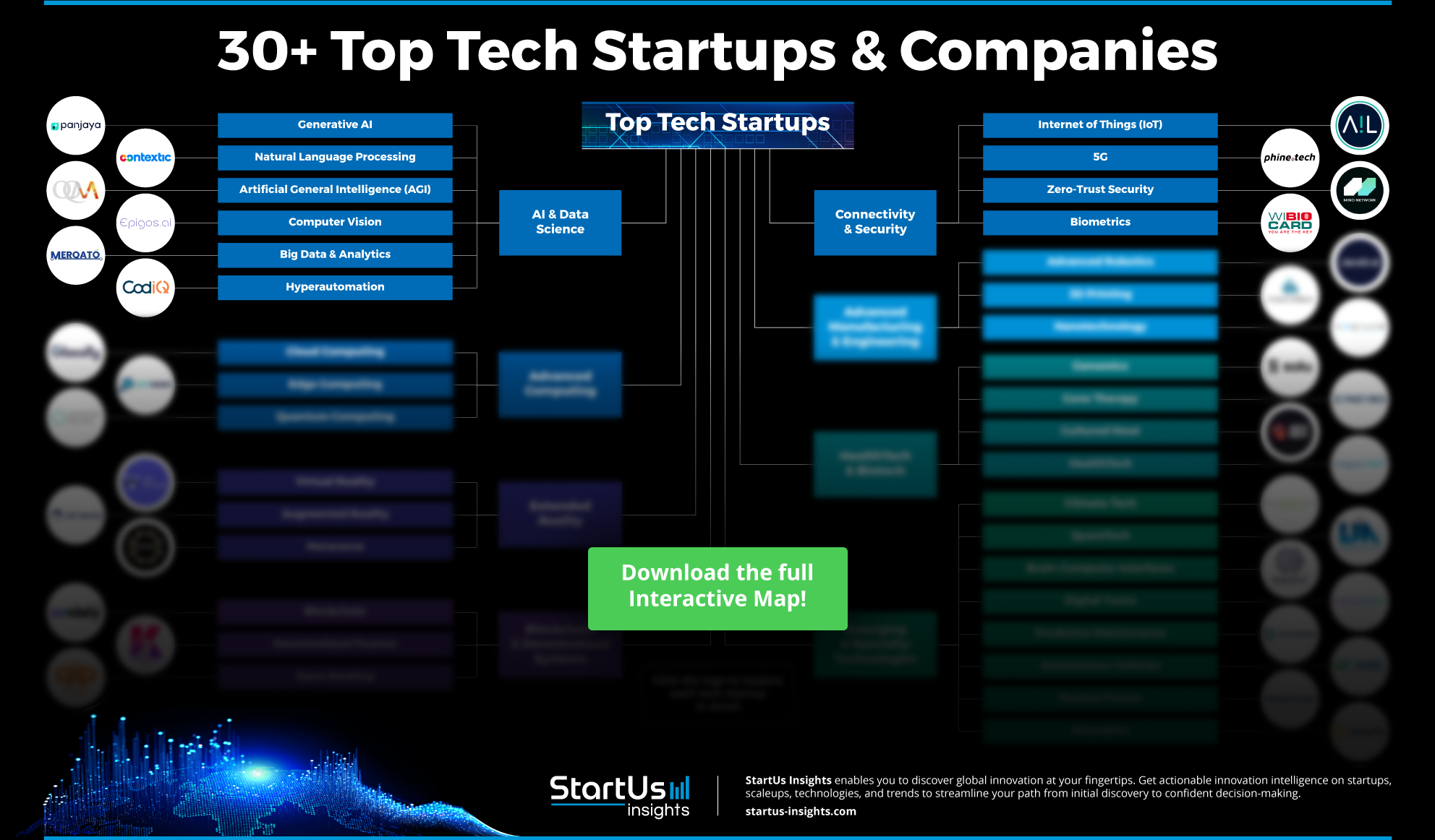
6. Painting and Coating
Robotic spray painting systems enable precise control over paint application for consistent coverage and to minimize overspray and waste. Electrostatic painting robots use charged particles to improve adherence and reduce material loss. Additionally, UV curing systems are employed to accelerate drying times for rapid production cycles. These technologies collectively improve product quality and worker safety by limiting exposure to harmful substances. Moreover, the integration of robotics in painting and coating increases productivity, consistency, and sustainability in manufacturing processes.
Noteworthy Example: KUKA specializes in industrial robots and automation solutions that improve paint applications, including water-soluble and powder paints.
Startup to Watch: Surface Engineering and Technologies
Surface Engineering and Technologies is a Pakistan-based startup that protects industrial assets from degradation and extends service life. The startup’s product thermal spray techniques include arc spray, flame spray, air plasma spray, high-velocity oxygen-fuel (HVOF) spraying, and laser cladding. These solutions are effective in applying specialized coatings for wear resistance, corrosion protection, and durability. The startup also offers metallization arc spray systems for both handheld and automated applications. Further, these systems offer features like the capability to switch between anti-corrosion and engineering coatings and consumables and accessories for optimal performance.
7. Maintenance and Repair
Autonomous inspection drones conduct real-time assessments of equipment and structures to identify wear and tear before issues escalate. Robotic repair systems align maintenance tasks in hazardous environments to execute complex procedures, such as sanding and painting. Swarm robotics are used for coordinated inspections, and in specialized systems for underwater asset maintenance. These developments reduce downtime and improve safety and precision allowing manufacturers to maintain assets more effectively.
Noteworthy Example: Bell and Howell maintain and repair industrial robots across multiple verticals, using real-time remote monitoring solutions to identify issues and offer preventive maintenance.
Startup to Watch: NISO Software Technologies
NISO Software Technologies is a Turkey-based startup that provides predictive maintenance solutions for industrial robots. It aligns manufacturing processes by minimizing equipment downtime and repair costs. Its predictive maintenance system collects data from industrial robots and applies machine learning algorithms to analyze power measurements. The system offers predictive and prescriptive analytics, anomaly detection, and alert management. By integrating internal data collection and providing real-time notifications through multiple channels, NISO improves and prevents unexpected production interruptions.
8. Additive Manufacturing
Robotic 3D printing and hybrid systems enable precise material deposition and multi-axis manipulation for complex geometries and larger parts. Wire arc additive manufacturing (WAAM) is key in producing large metal components for aerospace and automotive industries, where weight reduction and design flexibility are critical. Further, motion systems also improve precision for micron-level accuracy in intricate parts. Additionally, robotics integration accelerates production, design iterations, and product quality.
Noteworthy Example: ADAXIS‘s software, AdaOne, aligns the programming for robotic additive manufacturing applications across the aerospace, defense, and energy sectors.
Startup to Watch: FreeD Printing
FreeD Printing is a German startup that employs additive manufacturing technology to improve component production. It has a six-axis robotic system for multidirectional modeling that overcomes the kinematic limitations of traditional additive manufacturing. This system offers free-formed layers and the ability to model on curved surfaces or around existing objects, reducing support structures and post-processing. Consequently, the startup increases production efficiency by decreasing manufacturing time, saving resources, and offering customization and repair solutions. Further, FreeD Printing delivers large-format printing capabilities that improve strength and surface quality for industrial manufacturing needs.
9. Inspection and Quality Control
The advanced robotic system improves inspection and quality control using computer vision and AI. Automated systems provide fast and precise product evaluations. These systems allow easy detection of defects and offer compliance with strict standards. Vision inspection systems powered by machine learning enable real-time checks and automated measurements. These solutions increase accuracy, reduce manual labor and costs, and also prevent errors that lead to recalls. Additionally, in-line quality checks and automated data analysis offer continuous process improvement and underscore robotics’ impact on quality standards maintenance.
Noteworthy Example: Madox specializes in robotic inspection solutions that include vision-based systems and collaborative robots for welding inspection and functional testing.
Startup to Watch: Fruitful AI
Fruitful AI is a Switzerland-based startup that uses artificial intelligence to increase quality control in the beverage bottling industry. Its AI-powered inspection system scans and identifies defects at a rate exceeding 30 bottles per second for product safety and operational efficiency. The technology employs precision defect detection for identifying imperfections as small as a few micrometers. Additionally, the company integrates AI into manufacturing processes, which eliminates costly rework and minimizes waste.
10. Automated Packaging
Robotics in automated packaging offers efficiency and precision through AI, machine learning, and 3D vision systems. Robots handle diverse packaging tasks, streamlining processes, reducing labor costs, and increasing output speed. Case packing automation improves product grouping, while end-of-line solutions ensure seamless transitions to distribution. Robotics also excels in palletizing, sorting, and loading various package types. Further, the use of robotics technologies offers an increase in production rates, the safety of human workers, and added flexibility in adapting to changing production demands.
Noteworthy Example: Syntegon specializes in robotic packaging solutions through its Robotic Pick & Place (RPP) platform, which offers modular scalability and high efficiency.
Startup to Watch: YK-Robotics
Italian startup YK-Robotics simplifies robotic cell management with its automated packaging solutions. It offers rapid robotic cell motion auto-generation for improving trajectories and control movements through simulations that anticipate collisions during virtual setups to real-world applications. Further, the solution automatically adapts to hardware and layout changes, permitting modifications to robotic configurations and manipulated objects without altering any code.
With its customizable and intuitive human-machine interface (HMI), the startup enables operators to facilitate intelligent optimization through simple variable adjustments. The startup also offers a universal robotic platform that utilizes an object-oriented approach. This platform is compatible with leading robotic brands and machinery and enables maintenance of the full potential of each element. By connecting to ERP and MES systems, the solution also increases data collection and interconnectivity among robotic cells.
Act Now to Take Advantage of Top Manufacturing Robots
The investment landscape reveals diverse funding opportunities for robotics in manufacturing. Significant sources of capital include prominent investors such as Y Combinator, Techstars, 500 Global, and MassChallenge. Funding types span seed rounds, early-stage VC/Series A, debt financing, accelerator/incubator programs, and mergers and acquisitions. The average funding amount per round stands at USD 11.9 million, indicating robust financial interest in this sector.
Act now on the emerging robotic technologies transforming the manufacturing industry. With StartUs Insights, you swiftly discover hidden gems among over 4.7 million startups, scaleups, and tech companies, supported by 20K+ trends and technologies. Our AI-powered search and real-time database ensure exclusive access to innovative solutions, making the global innovation landscape easy to navigate.
Trusted by industry leaders like Samsung, Nestlé, and Magna, we provide unmatched data, a 360-degree industry view, and data-driven intelligence for confident strategic decisions. For instance, this is what Gianluca Grifi, Business Creation Manager (CLC South) of EIT Manufacturing says about our platform and service, “StartUs Insights’ reach enables us to attract a high number of relevant startups in a short amount of time as well as strengthen EIT Manufacturing’s brand in the global startup community.”
Like them, you can also leverage our innovation services to optimize costs, streamline operations, and stay ahead of the curve. Get in touch today to explore how our comprehensive innovation intelligence can drive your success.
Discover All Robotics-led Manufacturing Innovations & Startups!
